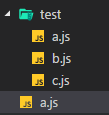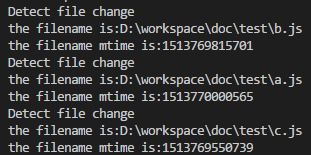.14-浅析webpack源码之Watchpack模块
解决掉了最头疼的DirectoryWatcher内部实现,这一节可以结束NodeWatchFileSystem模块。
关于watch的应用场景,仔细思考了下,这不就是热重载的核心嘛。
首先是监视文件,触发文件change事件后收集变动文件信息,重新进行打包,更新JS后触发页面重新渲染,perfect!
首先重新回忆一下NodeWatchFileSystem模块:
"use strict";
const Watchpack = require("watchpack");
class NodeWatchFileSystem {
constructor(inputFileSystem) {
this.inputFileSystem = inputFileSystem;
this.watcherOptions = {
aggregateTimeout: 0
};
this.watcher = new Watchpack(this.watcherOptions);
}
watch(files, dirs, missing, startTime, options, callback, callbackUndelayed) {
// ...
const oldWatcher = this.watcher;
this.watcher = new Watchpack(options);
// 当新监视器生成时立即调用的函数
if (callbackUndelayed)
this.watcher.once("change", callbackUndelayed);
// callback在这里调用
this.watcher.once("aggregated", (changes, removals) => { /**/ });
// 分别传入 文件目录数组 文件夹目录数组 时间标记
this.watcher.watch(files.concat(missing), dirs.concat(missing), startTime);
// 关闭旧监视器
if (oldWatcher) {
oldWatcher.close();
}
return {
close: () => {
if (this.watcher) {
this.watcher.close();
this.watcher = null;
}
},
pause: () => {
if (this.watcher) {
this.watcher.pause();
}
}
};
}
}
module.exports = NodeWatchFileSystem;
在构造函数中会初始化一个Watchpack实例赋给watcher,每一次调用watch方法会重新生成一个的watcher并同时关闭旧的watcher。
模块只有一个原型方法watch,参数解析如下:
1.files、dirs、missing为文件路径相关
2.options为初始化watchpack实例的参数
3.callback与callbackUndelayed为回调函数
这里有两个回调函数,一个在新监视器生成时立即调用,一个在监视器触发aggregated事件时调用。
返回的对象有两个方法,一个用来关闭监视器,一个用来暂停监视器。
下面看Watchpack模块源码,先从构造函数开始讲解:
class Watchpack {
constructor(options) {
EventEmitter.call(this);
// 参数处理
if (!options) options = {};
// 设置定时器参数默认值
if (!options.aggregateTimeout) options.aggregateTimeout = 200;
this.options = options;
this.watcherOptions = {
ignored: options.ignored,
poll: options.poll
};
// 文件监视器容器
this.fileWatchers = [];
// 文件夹监视器容器
this.dirWatchers = [];
// 指定文件修改时间容器
this.mtimes = Object.create(null);
// 暂停标记
this.paused = false;
// 定时器ID收集容器
this.aggregatedChanges = [];
this.aggregatedRemovals = [];
// 本地定时器参数
this.aggregateTimeout = 0;
this._onTimeout = this._onTimeout.bind(this);
};
// prototype methods...
}
大体上可分为容器、标记、参数三部分。
容器包括文件与文件夹的监视器容器以及几个定时器ID相关的容器,标记只有一个暂停标记,参数为定时器的时间参数。
下面是核心方法watch,源码整理如下:
Watchpack.prototype.watch = function watch(files, directories, startTime) {
// 暂停标记置false
this.paused = false;
// 取出旧的监视器
var oldFileWatchers = this.fileWatchers;
var oldDirWatchers = this.dirWatchers;
// 分别调用watchFile与watchDirectory对文件与文件夹进行监视
// 将监视器赋值给对应的容器
this.fileWatchers = files.map(function(file) {
return this._fileWatcher(file, watcherManager.watchFile(file, this.watcherOptions, startTime));
}, this);
this.dirWatchers = directories.map(function(dir) {
return this._dirWatcher(dir, watcherManager.watchDirectory(dir, this.watcherOptions, startTime));
}, this);
// 关闭所有旧的监视器
oldFileWatchers.forEach(function(w) {
w.close();
}, this);
oldDirWatchers.forEach(function(w) {
w.close();
}, this);
};
过了watchManager模块后,这里就变得十分简单明了,分别取出数组的目录元素,分别进行监视操作,将返回的监视器数组赋值给容器。
同样,每一次调用watch会关闭所有旧的监视器。
接下里是关于file与dir的不同处理:
_fileWatcher
// 传入文件路径与watcher
Watchpack.prototype._fileWatcher = function _fileWatcher(file, watcher) {
// 绑定change、remove事件的触发事件
watcher.on("change", function(mtime, type) {
this._onChange(file, mtime, file, type);
}.bind(this));
watcher.on("remove", function(type) {
this._onRemove(file, file, type);
}.bind(this));
return watcher;
};
如果看了上一节会发现,DirectoryWatcher模块内部源码只有emit触发事件,并没有任何on来处理事件。
这里就是处理模块内部事件触发的地方,触发change调用本地的_onchange方法,触发remove调用本地的_onRemove方法,参数没有什么解释的。
_dirWatcher
Watchpack.prototype._dirWatcher = function _dirWatcher(item, watcher) {
// 只是触发change事件
watcher.on("change", function(file, mtime, type) {
this._onChange(item, mtime, file, type);
}.bind(this));
return watcher;
};
文件夹只有增加和删除,一个change事件就足够了。
_onChange
// item、file都是文件路径
Watchpack.prototype._onChange = function _onChange(item, mtime, file) {
file = file || item;
// 新增或更新对应文件的修改时间
this.mtimes[file] = mtime;
// 暂停时不触发change事件
if (this.paused) return;
this.emit("change", file, mtime);
// 清除本地定时器
if (this.aggregateTimeout)
clearTimeout(this.aggregateTimeout);
// 变动文件
if (this.aggregatedChanges.indexOf(item) < 0)
this.aggregatedChanges.push(item);
// 设置定时器
this.aggregateTimeout = setTimeout(this._onTimeout, this.options.aggregateTimeout);
};
变动的文件信息会被加入到对应的容器,最后会调用一个定时器,定时器间隔为穿进来的参数。
_onRemove
Watchpack.prototype._onRemove = function _onRemove(item, file) {
file = file || item;
// 删除容器中对应的文件信息
delete this.mtimes[item];
if (this.paused) return;
// 触发remove事件
this.emit("remove", item);
if (this.aggregateTimeout)
clearTimeout(this.aggregateTimeout);
// 删除文件的信息加入容器
if (this.aggregatedRemovals.indexOf(item) < 0)
this.aggregatedRemovals.push(item);
// 触发aggregated事件
this.aggregateTimeout = setTimeout(this._onTimeout, this.options.aggregateTimeout);
};
_onTimeout
Watchpack.prototype._onTimeout = function _onTimeout() {
// 定时器ID置0
this.aggregateTimeout = 0;
// 变动与删除的文件信息数组
var changes = this.aggregatedChanges;
var removals = this.aggregatedRemovals;
// 清空
this.aggregatedChanges = [];
this.aggregatedRemovals = [];
// 触发aggregated事件
this.emit("aggregated", changes, removals);
};
简单概括就是会在给定时间后调触发aggregated事件,将变动与删除的文件信息数组作为参数传递出去并清空数组。
总体来说,文件的增加与内容修改会触发change事件,删除会触发remove事件。文件夹只有change事件。无论是触发change还是remove,都会将对应的文件信息用aggregated事件传递出去。
调用pause方法时,所有的操作将不会触发任何事件,但是文件修改信息仍然会被收集。
值得注意的是,源码内部并没有任何继续监视的方法,虽然有一个resume函数,但是:
Watchpack.prototype.close = function resume() { /**/ }
看到没,假的,虽然名字叫resume,但是实际上关掉了监视。继续监视唯一的办法是重新调用watch方法,但是会清空所有watcher容器并重新生成一批新的。也就是说,pause相当于stop。
源码中还有个getTimes的原型方法,有兴趣自己去看,暂时不讲了。
最后来用小案例模拟这些模块的使用,目录如图:
测试代码如下:
// 模块引入
// 我都复制过来了!
const Watchpack = require('./lib/watchpack');
const fs = require('fs');
const path = require('path');
// 实例化一个Watchpack类 不传参
const el = new Watchpack();
// 需要监视的文件夹
const rootPath = path.join(process.cwd(), 'test');
fs.readdir(rootPath, (err, items) => {
// 文件夹中的文件全部做监视
items = items.map((v) => path.join(rootPath, v));
// 对所有文件做监视
el.watch(items, [], 1);
});
// 监视change事件
el.on('change', (...args) => {
console.log('Detect file change\nthe filename is:' + args[0] + '\nthe filename mtime is:' + args[1]);
});
// 监视remove事件
el.on('remove', (...args) => {
console.log('Detect file remove\nthe filename is:' + args[0]);
});
这里暂时先不对文件夹进行监视,遍历test文件夹,将所有文件路径包装成数组传入watch方法(第三个参数真不懂啥意思,传1反正没错)。
在node指令执行的时候,就会打印出一连串的信息:

在初始化的时候,每一次生成一个监视器,就会先触发一次change事件,并初始化文件的mtime,触发的源码如下:
DirectoryWatcher.prototype.setFileTime = function setFileTime(filePath, mtime, initial, type) {
// ...
if (!old) {
if (mtime) {
// watch方法会设置该属性
if (this.watchers[withoutCase(filePath)]) {
this.watchers[withoutCase(filePath)].forEach(function(w) {
if (!initial || w.checkStartTime(mtime, initial)) {
// 触发事件
w.emit("change", mtime, initial ? "initial" : type);
}
});
}
}
}
// ...
}
这个地方的事件只会在初始化的时候被调用。
这里有一个小问题,在每一次初始化的时候会进行doInitScan扫描,扫描的文件信息会被填充到files容器中,即
// files
['D:\\workspace\\doc\\test\\a.js', 'D:\\workspace\\doc\\test\\b.js', 'D:\\workspace\\doc\\test\\c.js']
然后在watch方法有这么一段代码:
DirectoryWatcher.prototype.watch = function watch(filePath, startTime) {
//...
var data;
if (filePath === this.path) { /**/ }
// 获取文件
else {
data = this.files[filePath];
}
process.nextTick(function() {
if (data) {
var ts = data[0] === data[1] ? data[0] + FS_ACCURACY : data[0];
// 这里的startTime为1 肯定能进去
if (ts >= startTime)
watcher.emit("change", data[1]);
}
// ...
}.bind(this));
return watcher;
};
watch方法会在后面会尝试获取容器中的文件信息并处罚change事件,理论上这里会触发两次change,然而实际上只有一次。
原因就在初始化扫描时候使用了async模块的方法,即:
fs.readdir(this.path, function(err, items) {
// 扫描文件并将信息填入容器中
async.forEach(items, function(item, callback) {
// ...
})
});
该模块的方法全是异步调用,所以在watch方法调用的第一时刻,此时初始化扫描还在进行中,files容器仍然为空,在watch与doInitScan方法中加log,可以发现:

在watch方法完成后,扫描才开始。
扫描开始后,进程挂起等待文件操作行为,这里分别对文件进行各种操作:
修改文件内容


触发了change事件。
删除文件


触发了remove事件。
修改文件名


这里仅仅触发了remove事件。
原因在于,这个操作被系统认为是删除一个文件再增加一个文件,但是文件增加在监视文件时是不会触发任何事件的,也不会生成该文件的watcher,只会将该文件信息收集进files容器中,这个在之前讲过。
注意,顺序是先删后增,这里可以简单的log一下,因为在setFileTime中传了对应的事件类型,虽然没有用上,这里测试可以用用:

改名后,打印:

过程为,先触发了触发unlink事件,将文件删除,然后将新文件的信息加入到files容器中,然后触发文件的change事件。
接下来是文件夹监视操作,测试代码如下:
// 模块引入
// 我都复制过来了!
const Watchpack = require('./lib/watchpack');
const fs = require('fs');
const path = require('path');
// 实例化一个Watchpack类 不传参
const el = new Watchpack();
// 需要监视的文件夹
const directory = path.join(process.cwd(), 'test');
el.watch([], [directory], 1);
// 监视change事件
el.on('change', (...args) => {
console.log('change: ' + args.join(','));
});
注意,文件夹无论怎样都只会触发change事件。这里搞两张图片特别累,所以直接展示传过来的参数。
新建文件

文件路径与修改时间。
删除文件

只有文件路径,因为文件被删了。
文件改名

这个地方事就多了,这三处触发全部来源于setFileTime方法中:
DirectoryWatcher.prototype.setFileTime = function setFileTime(filePath, mtime, initial, type) {
// ...
if (this.watchers[withoutCase(this.path)]) {
this.watchers[withoutCase(this.path)].forEach(function(w) {
if (!initial || w.checkStartTime(mtime, initial)) {
w.emit("change", filePath, mtime, initial ? "initial" : type);
}
});
}
};
DirectoryWatcher.prototype.watch = function watch(filePath, startTime) {
this.watchers[withoutCase(filePath)] = this.watchers[withoutCase(filePath)] || [];
var watcher = new Watcher(this, filePath, startTime);
this.watchers[withoutCase(filePath)].push(watcher);
// ...
}
因为watch的是一个文件夹,所以在watcher容器中会有对应的键,所以任何文件的变动都会触发文件夹的change事件。
这里改文件名会涉及:删除文件触发一次,增加文件触发一次,change事件触发一次。
至此,基本上该watch模块的内容基本处理完毕,撒花!
.14-浅析webpack源码之Watchpack模块的更多相关文章
- .9-浅析webpack源码之NodeEnvironmentPlugin模块总览
介绍Compiler的构造比较无趣,不如先过后面的,在用到compiler的时候再做讲解. 这一节主要讲这行代码: // 不管这里 compiler = new Compiler(); compile ...
- .13-浅析webpack源码之WatcherManager模块
从模块流可以看出,这个NodeWatchFileSystem模块非常深,这里暂时不会深入到chokidar模块,有点太偏离本系列文章了,从WatcherManager开始讲解. 流程如图: 源码非常简 ...
- .12-浅析webpack源码之NodeWatchFileSystem模块总览
剩下一个watch模块,这个模块比较深,先大概过一下整体涉及内容再分部讲解. 流程图如下: NodeWatchFileSystem const Watchpack = require("wa ...
- .6-浅析webpack源码之validateSchema模块
validateSchema模块 首先来看错误检测: const webpackOptionsValidationErrors = validateSchema(webpackOptionsSchem ...
- .4-浅析webpack源码之convert-argv模块
上一节看了一眼预编译的总体代码,这一节分析convert-argv模块. 这个模块主要是对命令参数的解析,也是yargs框架的核心用处. 生成默认配置文件名数组 module.exports = fu ...
- .15-浅析webpack源码之WebpackOptionsApply模块-plugin事件流总览
总体过了一下后面的流程,发现Compiler模块确实不适合单独讲解,这里继续讲解后面的代码: compiler.options = new WebpackOptionsApply().process( ...
- .11-浅析webpack源码之Storage模块
至此已完成NodeJsInputFileSysten模块的讲解,下一步就是实际实用的模块: compiler.inputFileSystem = new CachedInputFileSystem(n ...
- .10-浅析webpack源码之graceful-fs模块
在cachedInput.output.watch三大文件系统中,output非常简单,没有必要讲,其余两个模块依赖于input模块,而input主要是引用了graceful-fs的部分API,所以这 ...
- .7-浅析webpack源码之WebpackOptionsDefaulter模块
WebpackOptionsDefaulter模块 通过参数检测后,会根据单/多配置进行处理,本文基于单配置,所以会进行到如下代码: if (Array.isArray(options)) { com ...
随机推荐
- 用Rider写一个由Autofac管理资源的WebAPI应用程序
一:步骤和上一篇创建控制台项目一样,不过这次选择的是.net core区域下的Asp.net web application,Type里选择Web API(Web API类似java里的SpringB ...
- utf-8转gb2312
近日在对一个json串进行转码时,显示中文乱码,原因是json串编码方式为utf-8,而我程序在windows上采用的是多字节编码方式,即采用gb2312编码.这里就存在一个utf-8到gb2312的 ...
- 在Azure DevOps Server的代理服务器安装Python环境
Python和Azure DevOps Server Python是一种计算机程序设计语言.是一种动态的.面向对象的脚本语言,最初主要为系统运维人员编写自动化脚本,在实际应用中,Python已经在前端 ...
- wpf使用FFMEPG录制屏幕
Simple function of recording screen based on ffmpeg Using WPF环境 Visual Studio 2017,dotNet Framework ...
- WPF 开机注册自启动及设置确保以管理员运行
最近用到开机自启动设置,在此记录下设置自启动的步骤,如果对各位有需要可以借阅,之前设置管理权限解释在创建解决方案是将VS以管理员方式打开,这种方法可以实现,但是个人还是偏向与本文的方式,不多说啥了,下 ...
- 基于DobboX的SOA服务集群搭建
本人第一次发博客,有什么不对的地方希望各位批评指正,我就不把文章copy过来了,直接上有道笔记的链接,希望各位喜欢. 第一部分: 准备工作 第二部分: dubbox的安装和使用 第三部分: RESTf ...
- LabVIEW(十四):VI属性
1.VI的属性在项目研究中是很常用的,但是会经常忽略VI的属性设置,建议在编程事常常运用这些属性的设置,这样就可以使你的程序更加完善,易懂性也会提高. 属性快捷键:Ctrl+I. 2.常规 (1).编 ...
- ElasticSearch5.0之后的改变
ES5的变化 search_type=count和scan都移除了 count可以用size=0代替 GET /my_index/_search { "size": 0, &quo ...
- Python3基础语法你学会了么
编码 默认:源码文件以UTF-8编码,字符串都是unicode字符串 指定: 标识符 第一个字符:字母表中的字符或下划线 _ 其它部分:由字母.数字.下划线 _ 组成 大小写敏感 python ...
- Data - References
01 - 数据分析与数据挖掘的知识列表 图解 知识列表 |关注方面|初级数据分析师|高级数据分析师|数据挖掘工程师| |--------|--------|--------|--------| | 数 ...
